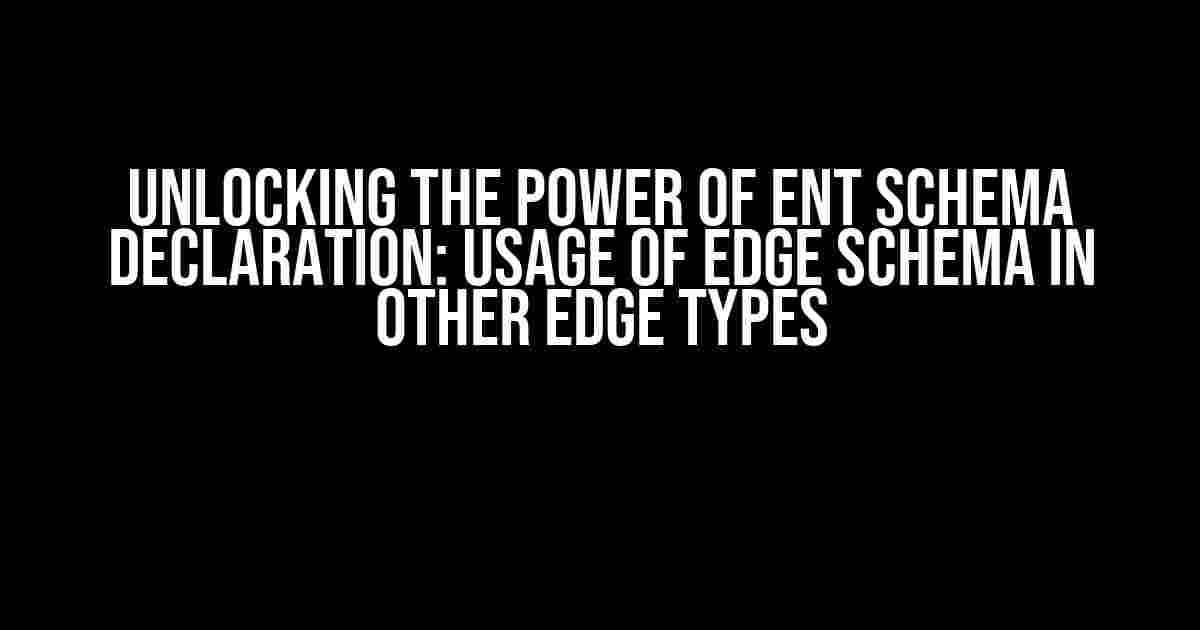When it comes to building robust and scalable data models, the Ent schema declaration plays a crucial role. But have you ever wondered how to take it to the next level by using Edge schema in other Edge types? In this comprehensive guide, we’ll dive deep into the world of Ent schema declaration and explore the limitless possibilities of Edge schema usage.
What is Ent Schema Declaration?
Before we dive into the juicy stuff, let’s quickly cover the basics. Ent schema declaration is a way to define the structure and relationships between entities in a data model. It’s a crucial step in building robust and scalable data models that can handle complex data relationships.
// Example of Ent schema declaration
entity User {
id: ID
name: String
email: String
friends: [User] @edge(type: "FRIEND")
}
What is Edge Schema?
In the context of Ent schema declaration, Edge schema refers to the definition of relationships between entities. Edges are used to connect entities, enabling you to model complex relationships between them.
// Example of Edge schema
edge FRIEND {
label: "FRIEND"
type: "FRIEND"
from: User
to: User
}
Usage of Edge Schema in Other Edge Types
Now that we’ve covered the basics, let’s explore the usage of Edge schema in other Edge types. This is where things get really interesting!
Using Edge Schema in Hierarchical Edges
Hierarchical edges are used to model tree-like structures, such as organizational charts or categorization systems. By using Edge schema in hierarchical edges, you can define complex relationships between entities.
// Example of Hierarchical Edge schema
edge CATEGORY {
label: "CATEGORY"
type: "CATEGORY"
from: Product
to: Category
inverse: "SUBCATEGORY"
}
edge SUBCATEGORY {
label: "SUBCATEGORY"
type: "SUBCATEGORY"
from: Category
to: Product
}
Using Edge Schema in Recursive Edges
Recursive edges are used to model relationships between entities of the same type, such as a user following another user. By using Edge schema in recursive edges, you can define complex relationships between entities.
// Example of Recursive Edge schema
edge FOLLOWER {
label: "FOLLOWER"
type: "FOLLOWER"
from: User
to: User
inverse: "FOLLOWING"
}
edge FOLLOWING {
label: "FOLLOWING"
type: "FOLLOWING"
from: User
to: User
}
Using Edge Schema in Many-to-Many Edges
Many-to-many edges are used to model relationships between multiple entities, such as a user belonging to multiple groups. By using Edge schema in many-to-many edges, you can define complex relationships between entities.
// Example of Many-to-Many Edge schema
edge GROUP_MEMBER {
label: "GROUP_MEMBER"
type: "GROUP_MEMBER"
from: User
to: Group
}
edge GROUP {
label: "GROUP"
type: "GROUP"
from: Group
to: User
}
Best Practices for Using Edge Schema
When using Edge schema in your Ent schema declaration, here are some best practices to keep in mind:
- Use meaningful labels and types: Use descriptive labels and types to make your Edge schema easy to understand and maintain.
- Define inverse edges: Define inverse edges to enable bi-directional navigation between entities.
- Use edge properties wisely: Use edge properties to store additional metadata about the relationship between entities.
- Keep it simple and consistent: Avoid over-engineering your Edge schema and stick to a consistent naming convention.
Conclusion
In conclusion, using Edge schema in other Edge types is a powerful way to model complex relationships between entities in your data model. By following the best practices outlined in this guide, you can unlock the full potential of Ent schema declaration and take your data model to the next level.
| Edge Type | Description | Example |
|---|---|---|
| Hierarchical Edge | Models tree-like structures | Product -> Category |
| Recursive Edge | Models relationships between entities of the same type | User -> User |
| Many-to-Many Edge | Models relationships between multiple entities | User -> Group |
By mastering the art of Edge schema declaration, you’ll be able to build robust and scalable data models that can handle even the most complex data relationships. So, what are you waiting for? Start exploring the world of Ent schema declaration today!
Stay tuned for more articles on Ent schema declaration and Edge schema usage!
Frequently Asked Question
Get the inside scoop on Ent schema declaration and the usage of Edge schema in other Edge types, with more indexes!
What is the primary purpose of declaring an Ent schema, and how does it relate to Edge schema?
Declaring an Ent schema defines the structure of entities and their relationships, while Edge schema focuses on defining the connection between entities. Think of Ent schema as the blueprint for your entities, and Edge schema as the bridges that link them together, allowing for efficient querying and traversal of the graph.
How do I reuse Edge schema in other Edge types, and what are the benefits of doing so?
You can reuse Edge schema in other Edge types by defining a new Edge type that extends the existing one. This approach promotes consistency, reduces redundancy, and enables more efficient data modeling. By reusing Edge schema, you can also take advantage of existing indexing and query optimization.
What role do indexes play in optimizing Edge schema, and how do I declare them?
Indexes significantly improve query performance by facilitating fast lookup and traversal of Edge connections. You can declare indexes on Edge schema by specifying the indexed fields and their type (e.g., hash, range, or text) using the `@index` directive.
Can I combine multiple Edge schema into a single Edge type, and what are the implications of doing so?
Yes, you can combine multiple Edge schema into a single Edge type using the `union` keyword. This approach can simplify data modeling and reduce the number of Edge types. However, it may lead to increased complexity and reduced query performance, so use it judiciously and consider the trade-offs.
How do I ensure data consistency and integrity when reusing Edge schema in other Edge types?
To ensure data consistency and integrity, define clear rules and constraints for Edge schema reuse, such as data validation and normalization. Additionally, establish a robust testing framework to catch any potential issues and ensure that reused Edge schema conform to the expected behavior.


